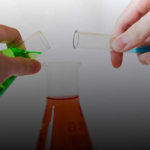Section 1
Preview this deck
double displacement reaction
Front
Active users
0
All-time users
0
Favorites
0
Last updated
4 years ago
Date created
Mar 1, 2020
Cards (70)
Section 1
(50 cards)
double displacement reaction
solubility
a measure of how much solute can dissolve in a given solvent at a given temperature.
proton
A subatomic particle that has a positive charge and that is found in the nucleus of an atom
chemical change
a change in matter in which a substance changes into a new substances with new physical and chemical properties.
Catalyst
A substance that speeds up or slows down the rate of a reaction without being consumed or altered.
metalloids
Inhibitor
A substance that slows down or stops a chemical reaction
evaporation
liquid to a gas
exothermic
a chemical reaction in which energy is primarily given off in the form of heat; examples: candle flame, rusting iron
Energy
It takes ____________________ to break bonds.
neutron
A subatomic particle that has no charge and that is found in the nucleus of an atom
physical change
a change in a substance that was either size/shape or change in state
dissolve
to form a solution by mixing evenly
condensation
gas to a liquid
gas
Molecules are very far apart that form no definite shape or size - molecules will spread out as far as possible.
single displacement reaction
metals
Precipitate
A solid that forms from a solution during a chemical reaction.
Chemical Bond
the force that holds two atoms together in a molecule.
freezing
liquid to a solid
product
a substance that is formed in a chemical reaction.
noble gases
decomposition reaction
liquid
Molecules are farther apart that form a definite size but not a definite shape (takes the shape of its container).
water
The universal solvent.
solution
When a solute is dissolved in a solvent and creates a mixture.
Atomic Mass
total mass of protons and neutrons
melting
solid to a liquid
nucleus of atom
the positively charged center of an atom (made of protons and neutrons)
reactant
a substance that takes part in a chemical reaction.
alkali metals
Atomic Number
Number of protons in an atom
transition metals
Solute
Is the substance or mix that is dissolved in the solvent to create a solution.
solid
Molecules are very close together forms a definite shape and size
electron
A subatomic particle that has a negative charge *smallest part of the atom
actinides
lanthanides
alkaline earth metals
halogens
atom
smallest unit of matter
synthesis reaction
What is the most reactive element?
Fluorine
chemical reaction
a process in which one or more substances are transformed into another substance
Mixture
When 2 or more substances are physically blended and can be separated easily because they are not bonded together like chemical reactions.
endothermic
a chemical reaction that forms with absorption of heat; examples: melting ice, cooking an egg, splitting ion pairs
Chemical Formula
A combination of chemical symbols and numbers to represent a substance
Solvent
Is the substance that the solute goes into.
nonmetals
coefficient
a number that multiplies a term in an equation, which indicates the number of each type of molecule.
Section 2
(20 cards)


